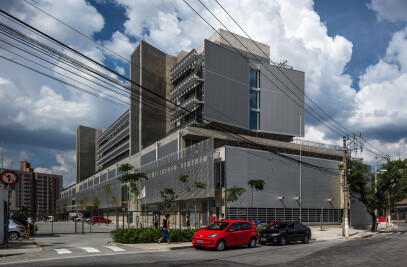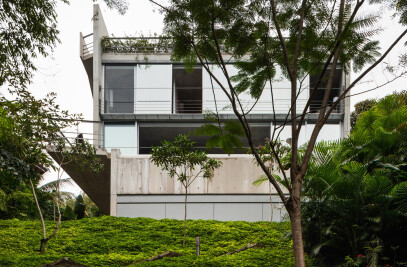The Pontifícia Universidade Católica do Rio de Janeiro — PUC-Rio — Mediatheque project takes into account two existing ground levels as an initial approach for its dual program:
[1] The lower ground level houses the book collection and administrative offices and acts as support building; [2] The upper ground level houses the plaza providing access to the public building.
1. The Support Building The roof of the support building is a reflecting pool which forms the Mediatheque Plaza. This plaza is a natural extension of the existing pilotis — pier-supported — area, the most important meeting point on the campus.
The reflecting pool’s water is poured onto the slab as soon as the concrete is cast in order to make it impermeable. This is a simple procedure which spares the use of any membrane or chemical products and provides efficient thermal insulation. In addition, the pool supports a tropical water garden, a typical strategy used in Brazilian architecture to mitigate Rio de Janeiro’s hot climate.
The support building houses the book collection and administrative areas.
The program distribution is simple: all book shelves are organized inside an enclosed glass rectangle which is surrounded by offices. This configuration provides a double advantage:
a . Offices have natural light, providing a pleasant work space. The free polygonal outline that defines the offices’ facades was shaped in order to keep the most existing trees. b. The book collection is separated from the external facades, drastically reducing energy consumption.
2. The Public Building The public building is connected to both upper and lower ground levels.
The foyer floor The plaza visitors access the foyer floor by a half level ramp. Though the plaza is on the upper ground level, it is also linked to the lower ground level by ramp and stairs, connecting both levels to several paths in the campus area. In this transitional space between the plaza and the main reading room, the front desk welcomes and informs visitors and provides free reading and studying spaces.
The main reading room floor The main reading room was designed to be the most impressive experience in the building. Its enormous dimensions - 90 m long, 15 m wide and three stories high – host multiple activities and spaces.
The East-West facades have no glazing. They are kept completely opaque to prevent solar radiation and direct sun light inside the reading room. Conversely, both North - South facades – are completely glazed and properly shaded by sun sails. Some special devices were designed to provide natural light to the space in between both transversal facades:
[1] The void carved on the long facades works as a “natural lamp” to the main reading room and provides an outside reading space to the visitors. Conceptually, it acts like a piece of outside space enclosed inside the building.
[2] Two sections of glass floor above the main reading room allow natural light from the clerestory pass through.
The researchers’ and UNESCO chair floor The researchers’ and UNESCO chair have a whole floor conceived to support both activities according to their specific programs and spaces requirements.
* * * The Building Structure and Construction Strategy The support building and public building were viewed as two independent structural pieces.
The structure of the support building is mostly loaded on the floor [book collection] like most low rise buildings. The scheme is simple: a reinforced concrete slab resting on a grid of small reinforced concrete columns. This is a flexible design strategy, since it is relatively easy to change the building's shape in order to preserve the existing trees. The supporting concrete walls were placed in different directions, taking the horizontal shear and relieving the load on internal columns. The support building will be cast on-site using traditional methods.
The public building structure is made by a pair of trusses, each one resting on two columns. Although the nominal dimensions of these trusses [ 45 m of span and cantilevers of 15 m and 30 m ] sound enormous, it is a well proportioned structure, once the available height for these trusses [ around 15 m ] are considered. In addition, it is also more efficient for the foundation to have just four columns. All floors in this building will be built using steel beams and pre-cast slabs.
The longitudinal façades are externally opaque. The trusses are closed by a 5mm-thick steel boards with continuously welded joins. Structurally, these façades are composed by several layers: steel, air barrier, thermal insulation, mechanical spaces and acoustic panels. The main advantage of this solution is the balance achieved between the building's temporal and acoustical performance, based on the results of specialized software simulations. As a result, the Mediatheque could easily achieve international standards of sustainability. The public building is an industrialized construction; its parts will be fabricated in factories and assembled on-site.

































